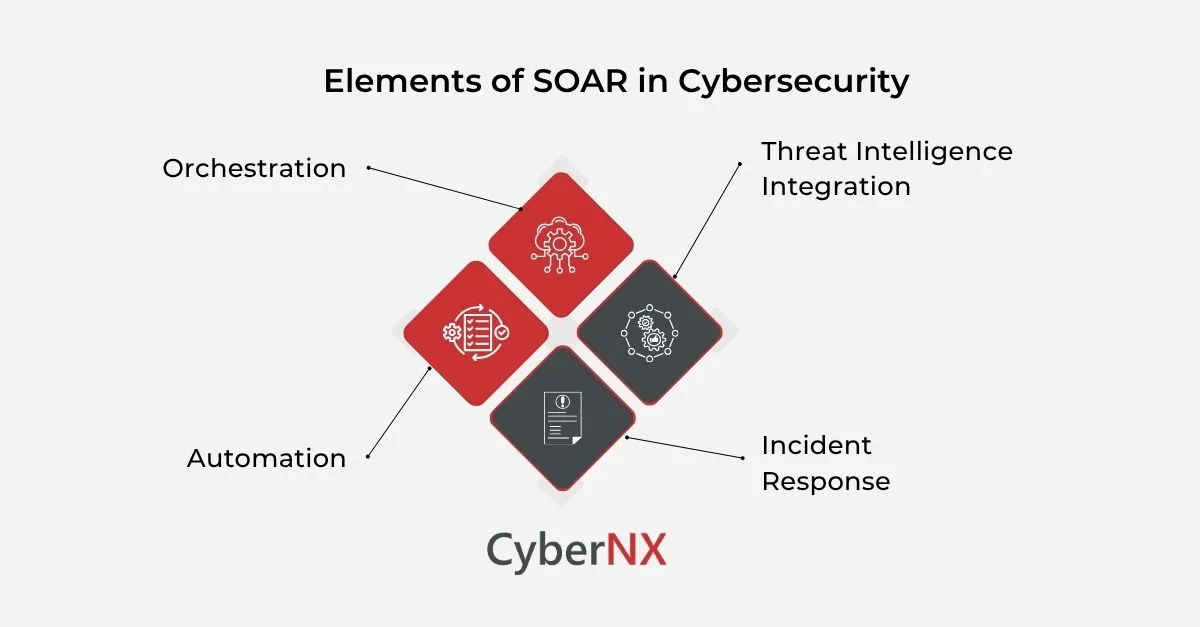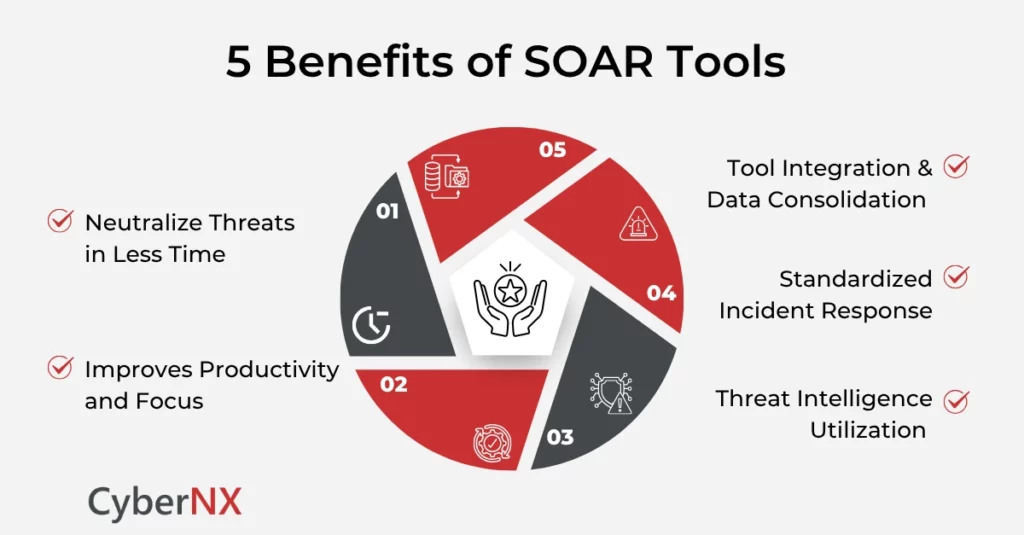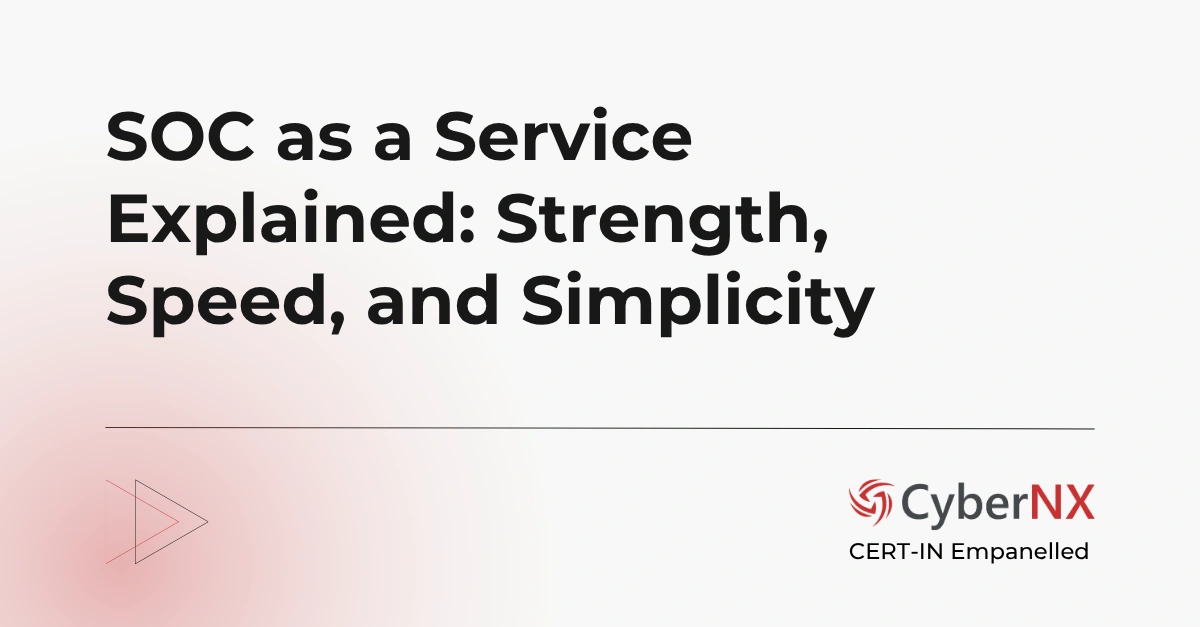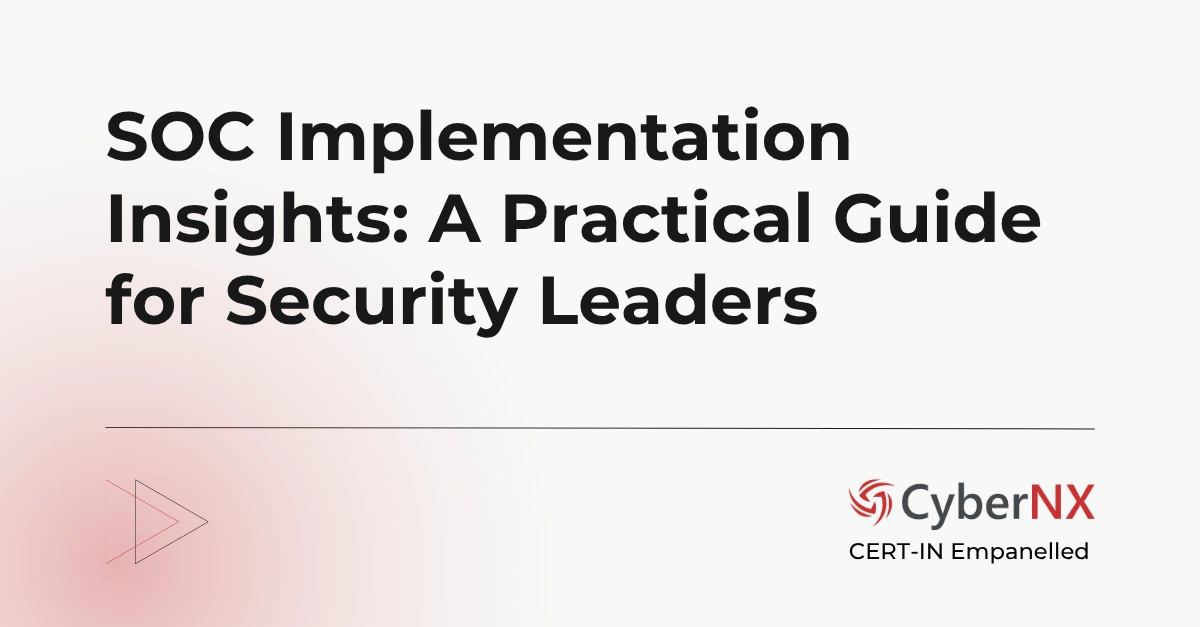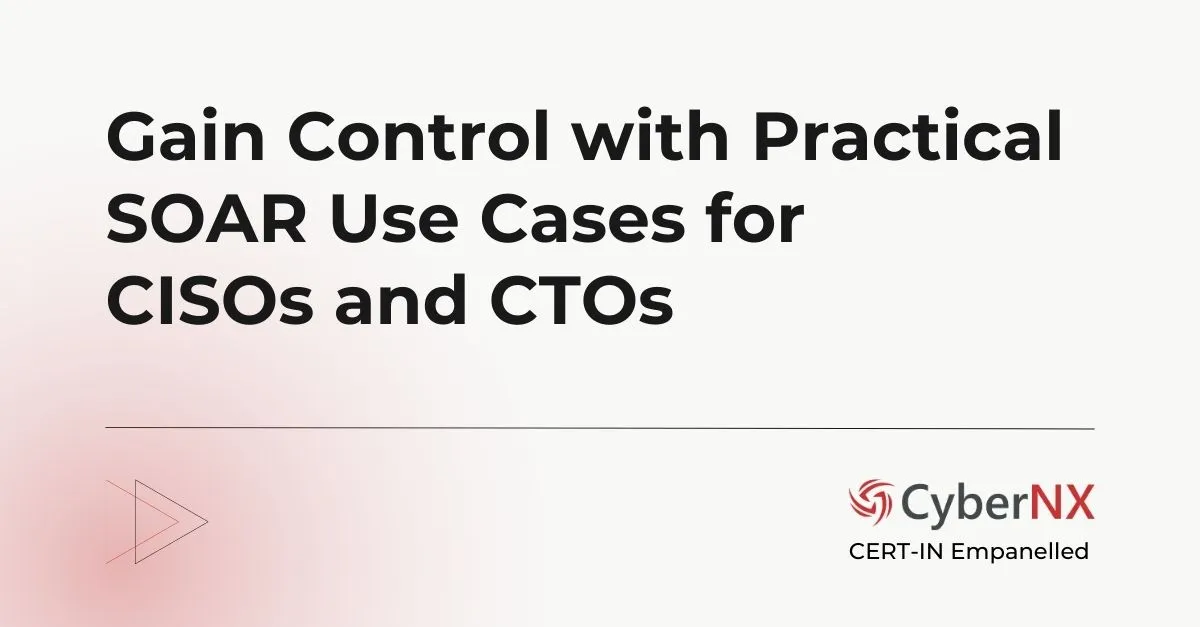As cyberattacks become relentless and response windows shrink, modern businesses cannot afford delays. The longer a breach lingers, the heavier the cost. IBM’s Cost of a Data Breach Report supports this assertion, stating that “organizations that contained breaches in under 200 days saved an average of 1 million dollars compared to those who took longer, a 23% cost difference.”
This huge gap highlights what our experts always say: speed matters. That’s where Security Orchestration, Automation and Response (SOAR) helps. It integrates security people, processes and plethora of disparate tools and technologies, boosting speed and efficiency.
SOAR solutions accelerate detection and response by reducing analyst fatigue and bringing a structure to incident handling.
What is SOAR Security?
Security Orchestration, Automation and Response is a cybersecurity solution that accomplish three key things: integration of different tools, automation of repetitive, tedious tasks and seamless workflows for incident and threat response.
Security Operations Center (SOC) use SOAR security platform to achieve faster, consistent and efficient threat handling and response. If you need more clarity or context about SOC, read our blog SOC Guide.
Large organizations with holistic security programs usually use tons of tools. However, manual discovery and analysis of data about threats is time consuming. And time is of essence in security.
Security Orchestration, Automation and Response platform essentially acts as a central console where data is gathered and presented from various security tools used in an organization. To be precise, SOAR security platform keeps all the alerts generated by tools used for different purposes at one place. This makes it easier for SOC analysts to prioritize alert, reduce MTTD and MTTR and boost response times.
Understanding Elements of SOAR in Cybersecurity
SOAR security platforms comprising four key capabilities orchestration, automation, response and threat intelligence, combines them into one single offering. Effective integration and application of these Security Orchestration, Automation and Response elements acts as a force-multiplier for security operations.
1. Orchestration
Just to set the premise, SOC or security teams in general use hardware and software of so many types. This involves different vendors. Plus, they use several non-security tools. All of them to organize, maintain and keep up the security health of an organization.
Now what if all these tools can be coordinated and processes stringed together? The result is a productive, enhanced workflow. Orchestration does this for security operations.
On a deeper level, SOAR unifies disparate tools such as firewalls, endpoint protection systems, SIEMs, vulnerability scanners, email security gateways, into a single operating framework. How? APIs and plugins help by connecting all these tools together.
Here is an example: Suppose an email security tool generates an alert for a phishing mail. Orchestration part of SOAR tool ensures the following:
- Alert flows seamlessly through the SIEM
- Retrieves user profile data from Active Directory
- Scans attachments using sandboxing, and
- Creates an incident in the ticketing system
All of this can be done according to the playbook, which could be manual, fully automated or hybrid.
2. Automation
Automation, in general, eliminates repetitive, tedious tasks. Same is the case with SOAR and security. Processes related to ticketing, enriching events and prioritizing alerts are automated through security orchestration and automation. Plus, Security Orchestration, Automation and Response has the capability to inform security analysts about any triggers from other security tools. This makes actions like blocking IPs, isolating endpoints and disabling a compromised user account easy.
Here is an automation example: Assume a malicious executable is identified in your employee’s inbox. SOAR tool will automate file detonation in a sandbox and checking hash against threat intelligence feeds. Additionally, if it is confirmed malicious, Security Orchestration, Automation and Response will trigger the firewall to block the domain and remove the email from mailboxes. Also, it will notify the incident response team.
3. Incident Response
Playbooks in SOAR security platforms contain the standard processes(step-by-step) which needs to be followed for threat detection and response. SOCs use these playbooks to integrate different tool activities, gather and remove false alerts and focus on threats that matter. All of this helps analysts to respond effectively.
For example, a ransomware alert might initiate a tiered response. It will involve isolation of the affected device, capturing system logs, terminating suspicious processes, alerting the IR team and generating a detailed timeline.
Every action is tracked, ensuring compliance and audit-readiness. Security Orchestration, Automation and Response platforms also provide case management features that allow analysts to conduct post-mortem of incidents with full context, notes, timelines and evidence in one place.
4. Threat Intelligence Integration
Security Orchestration, Automation and Response platforms enrich raw alerts with contextual data. This is possible due to its coordination capabilities with multiple security tools like SIEM, EDR and more. Consequently, it helps in faster and accurate decision-making.
For example, a SOC analysts may find a domain suspicious. But it might not be enough to take appropriate actions. SOAR tools correlate the existing data with known malware campaigns, geolocation data and internal traffic logs. This makes the risk profile clear. Moreover, the system can keep the learnings for future detections, improving resilience over time.
5 Benefits of Security Orchestration, Automation and Response
SOAR in IT security gives your operations a strategic and operational edge by speeding up the detection and response processes making it a core pillar of soar cyber strategies. Here are the other benefits:
1. Neutralize Threats in Less Time
Automation of triage and execution of predefined playbooks, SOAR security platforms cut the time it takes to detect, analyse and neutralize threats. It empowers security teams to respond in minutes, which otherwise could take hours or even days. Faster response means reduced dwell time, helping organizations avoid data exfiltration, financial loss, and reputational damage.
2. Improves Productivity and Focus
Organization using SOAR approach can eliminate routine and repetitive tasks like pulling IP reputation, collecting logs and escalating alerts. This, in turn, saves analyst from unwanted burnout. Plus, Security Orchestration, Automation and Response automation allows analysts to focus on high-value organizational goals such as threat hunting, strategic decision-making and tuning detection rules. This shift also boosts morale, reduces turnover and makes the SOC effective and productive.
3. Tool Integration & Data Consolidation
As discussed before, organizations often use dozens of security tools. What it does is create fragmented workflows and data silos, headache for SOC teams. SOAR brings these tools into a cohesive, centralized ecosystem, consolidating alerts, telemetry and threat data. This improves visibility, reduces alert noise and allows for centralized response.
4. Standardized Incident Response
SOC is a 24X7 security thing. This is because anything can breach the systems in a split second. Such intense scrutiny takes a lot out of you. Thus, security teams sometimes struggle with inconsistent responses across shifts and locations. SOAR security platform supports SOC teams by enforcing standardization through structured playbooks. This ensures every incident is handled according to the established policy. Additionally, each action is logged, time-stamped and auditable, supporting compliance with regulations like GDPR, HIPAA and PCI-DSS.
5. Threat Intelligence Utilization
With built-in threat intelligence connectors, SOAR automatically enriches alerts using external feeds and regularly updated internal knowledge bases. This enrichment accelerates triage, improves decision accuracy and ensures intelligence is applied uniformly across incidents. It also enables proactive defence by identifying patterns and feeding insights into detection mechanisms.
Top SOAR Tools in the Market (2025)
| Tool | Key Strength |
| IBM Security QRadar SOAR | Powerful orchestration, deep integrations, case management |
| Palo Alto Cortex XSOAR | Unified platform for threat intel, automation, and response |
| Splunk SOAR | Visual playbook builder, strong community content |
| Swimlane Turbine | Low-code SOAR, scalable automation |
| Siemplify (by Google) | Easy integration with SIEM, flexible playbook creation |
These SOAR security platforms differ in architecture, licensing, and focus. But all of them aim to achieve the same goal: faster, smarter and scalable security operations.
Read our blog SOAR Tools packed with insights to help you make the right decision.
Things to Look for in a SOAR Platform
Evaluate the best Security Orchestration, Automation and Response platforms based on these key aspects:
1. Seamless Integration Ecosystem
One of the primary functions of a Security Orchestration, Automation and Response platform is to bring together all the disparate tools. Thus, the effectiveness of SOAR tool hinges on how well it integrates with your tech stack, your existing SIEM, firewall, email security, EDR, cloud platform and ticketing systems. While you discussed SOAR tools, look for solutions with apt APIs, pre-built plugins and native integrations.
2. Flexible & Customizable Playbooks
Playbooks make automation possible. An efficient and productive SOAR security platform will offer you drag-and-drop builders for creating complex workflows without requiring deep coding expertise. Go for such SOAR tools as it makes life easy for security teams. To go more technical, the Security Orchestration, Automation and Response platform you choose should also support conditional logic, nested workflows, approval gates and the ability to call custom scripts when needed. This flexibility and customization approach ensures that the platform can adapt to unique business needs.
3. Case & Incident Management
Beyond the advantage of automation, a strong SOAR solution acts as a centralized system for case management. It should allow SOC analysts to assign roles, track progress, view incident timelines, attach evidence and maintain collaborative notes. Post-incident case closure should be followed by auto-generated reports for audits, reviews and regulatory requirements.
4. Scalability & Deployment Flexibility
Scaling is the part and parcel of any and every mid-size business or a global enterprise. The Security Orchestration, Automation and Response platforms therefore should be capable of scaling without performance issues.
Learn about different modern SOAR platforms that are cloud-native or offer hybrid deployment options, elastic processing and role-based access controls. Also evaluate how the platform handles high alert volumes, supports multi-tenancy (for MSSPs) and high availability (HA) configurations, per your business needs.
SOAR vs SIEM: What’s the Difference?
While both SOAR and SIEM serve the SOC, their roles differ fundamentally:
| Feature | SIEM | SOAR |
| Primary Function | Log collection, correlation, alerting | Orchestration, automation, response |
| Analyst Role | Detect and investigate | Investigate and respond |
| Automation | Minimal | Extensive, rule-based automation |
| Integration | Primarily data sources | Security tools, workflows, case management |
| Output | Alerts and dashboards | Playbooks, cases, automated actions |
Together, SIEM and SOAR create a powerful security operations ecosystem: SIEM provides visibility, while SOAR empowers action.
Get the full breakdown in our detailed blog SIEM vs SOAR.
Conclusion
Cyberattacks continue to become faster, targeted and frequent. Relying on human plus automation driven response is the way ahead for modern businesses. You need a robust solution that unifies the entire security ecosystem, automates whatever is possible and empowers analysts to act decisively. Security Orchestration, Automation and Response delivers exactly that.
SOAR in cybersecurity reduces breach costs, boosts response times and helps with compliance at the speed which a business needs.
Our SOAR consulting services helps your business achieve greater security operation efficiency. Plus, our experts help you get maximum value from the SOAR tools. Contact us today.
Security Orchestration, Automation and Response FAQs
Can SOAR help during a zero-day attack?
Yes. While Security Orchestration, Automation and Response won’t detect a zero-day directly, it can respond swiftly once a threat is identified – by isolating assets, collecting forensics, and alerting teams via predefined playbooks. It also allows integration with advanced threat intelligence feeds that may flag suspicious behaviours even before signatures exist. Over time, the lessons from the attack can be codified into playbooks to ensure faster response if similar zero-day behaviour re-emerges.
How long does it take to implement a SOAR platform?
Implementation can range from a few weeks to months depending on tool integrations, team readiness, and use case complexity. Low-code platforms reduce deployment time significantly. Pilot projects using predefined playbooks and connectors can help accelerate time-to-value. However, tailoring Security Orchestration, Automation and Response to your unique environment – integrating legacy systems, writing custom playbooks, and training analysts – can extend the timeline.
Is SOAR useful for smaller security teams?
Absolutely. Even lean security teams benefit from SOAR’s automation, reducing manual load and letting analysts focus on strategy instead of routine tasks. For organizations without 24/7 monitoring, Security Orchestration, Automation and Response can serve as a digital first responder, executing key actions during off-hours or when the SOC is overwhelmed. It helps level the playing field against larger, more resourced adversaries.
Can SOAR be extended beyond cybersecurity use cases?
Yes. Many organizations use Security Orchestration, Automation and Response for IT operations—automating patch workflows, access requests, and even DevSecOps alerts – making it a valuable cross-functional platform. From compliance checks and system health monitoring to automating user onboarding workflows, SOAR’s orchestration and automation capabilities are being embraced across IT and infrastructure teams to reduce operational burden.


